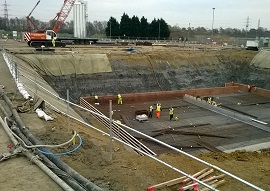Ground
The term ‘ground’ typically refers to the solid surface of the Earth or an area that is used for a specified purpose.
It can also be used to refer to the storey of a building that is on the ground, i.e. ‘ground level’ or ‘ground floor’.
In terms of the physical matter of the ground, it is made up of different layers. Topsoil is the first, upper layer of soil, typically measuring between 5 - 20 cm (2 - 8 inches) deep. It can also be measured as the depth from the surface level to the subsoil, i.e. the distance to the first densely-packed layer of soil. Subsoil is the layer (or stratum) of soil immediately underneath the surface topsoil. Beneath the subsoil is the substratum - a layer of residual bedrock, sediments or deposits.
The ‘water table’ is the below-ground level that marks the transition between ground that is saturated with water and ground that is not saturated. The upper, unsaturated level, is known as the 'capillary fringe' or 'zone of aeration'.
In terms of construction, ‘groundworks’ refers to work done to prepare sub-surfaces for the start of construction work. Aside from any demolition or site enabling works that may need to be carried out, groundworks are usually the first stage of a construction project.
Ground investigations are a means of determining the condition of the ground, ideally before beginning construction works. They focus specifically on intrusive geotechnical work such as trial pits and boreholes. An assessment of ground conditions typically includes geology, hydrology, hydrogeology and soil conditions of a site and surrounding, along with any contaminated land.
There are a number of ground improvement or ground modification techniques that can be used to stabilise or improve the condition of an area of ground before construction work takes place. This may be necessary to improve or modify the ground shear strength, stiffness, permeability, and so on.
Designing Buildings Wiki has a number of articles relating to the ground, including:
- Alluvium.
- Bearing capacity.
- Building foundations.
- Clay.
- Contaminated land.
- Ecological survey.
- Excavation.
- Geophysical survey.
- Ground anchor.
- Ground conditions.
- Ground energy options.
- Ground heave.
- Ground improvement techniques.
- Ground level.
- Ground-penetrating radar.
- Ground source heat pumps.
- Ground storey.
- Groundworks.
- In situ testing of soils.
- Land surveying.
- Methane and other gasses from the ground.
- Minerals surveyor.
- Road construction.
- Settlement.
- Sinkholes.
- Soil report.
- Soil survey.
- Subsidence.
- Subsoil.
- The importance of soil analysis.
- Topsoil.
- Types of soil.
- Underpinning.
- Underreaming.
- Vibro-compaction.
- Water table.
[edit] Related articles on Designing Buildings Wiki
Featured articles and news
International Electrician Day, 10 June 2025
Celebrating the role of electrical engineers from André-Marie Amperè, today and for the future.
New guide for clients launched at Houses of Parliament
'There has never been a more important time for clients to step up and ...ask the right questions'
The impact of recycled slate tiles
Innovation across the decades.
EPC changes for existing buildings
Changes and their context as the new RdSAP methodology comes into use from 15 June.
Skills England publishes Sector skills needs assessments
Priority areas relating to the built environment highlighted and described in brief.
BSRIA HVAC Market Watch - May 2025 Edition
Heat Pump Market Outlook: Policy, Performance & Refrigerant Trends for 2025–2028.
Committing to EDI in construction with CIOB
Built Environment professional bodies deepen commitment to EDI with two new signatories: CIAT and CICES.
Government Grenfell progress report at a glance
Line by line recomendation overview, with links to more details.
An engaging and lively review of his professional life.
Sustainable heating for listed buildings
A problem that needs to be approached intelligently.
50th Golden anniversary ECA Edmundson apprentice award
Deadline for entries has been extended to Friday 27 June, so don't miss out!
CIAT at the London Festival of Architecture
Designing for Everyone: Breaking Barriers in Inclusive Architecture.
Mixed reactions to apprenticeship and skills reform 2025
A 'welcome shift' for some and a 'backwards step' for others.
Licensing construction in the UK
As the latest report and proposal to licence builders reaches Parliament.
Building Safety Alliance golden thread guidance
Extensive excel checklist of information with guidance document freely accessible.
Fair Payment Code and other payment initiatives
For fair and late payments, need to work together to add value.
Pre-planning delivery programmes and delay penalties
Proposed for housebuilders in government reform: Speeding Up Build Out.
High street health: converting a building for healthcare uses
The benefits of health centres acting as new anchor sites in the high street.

























